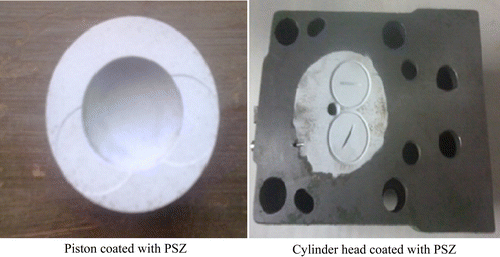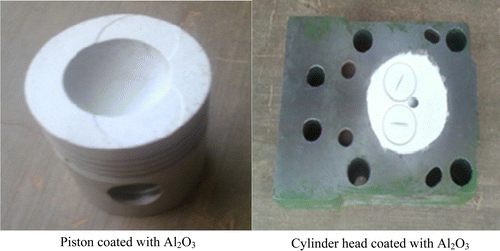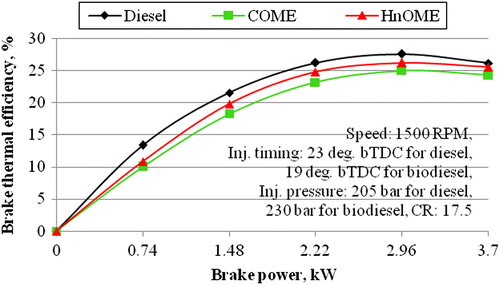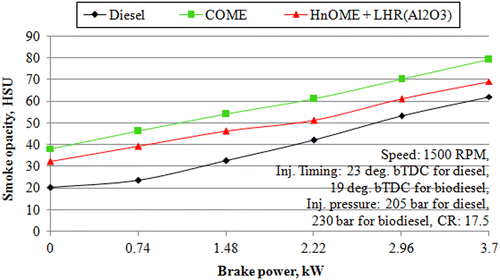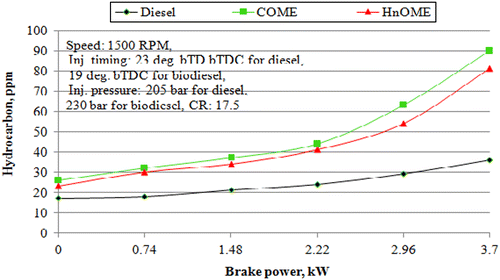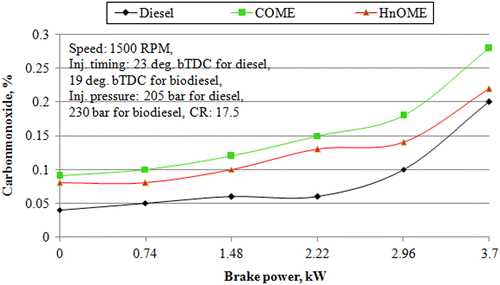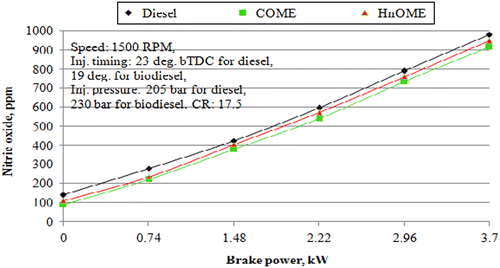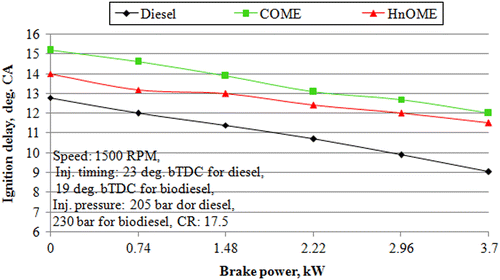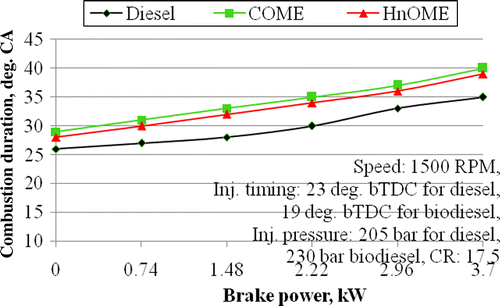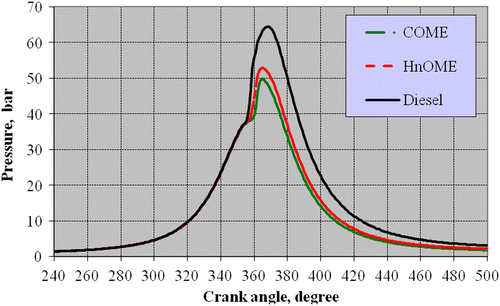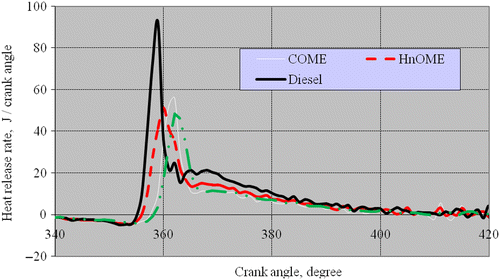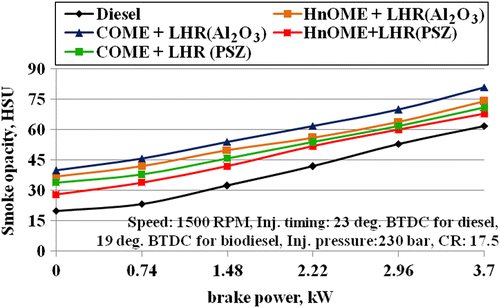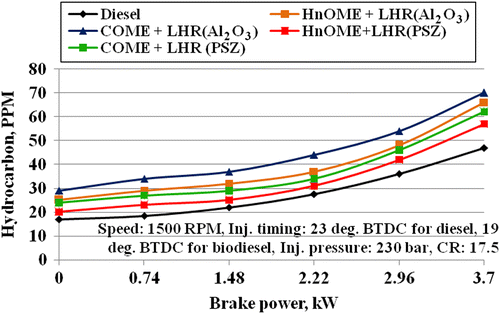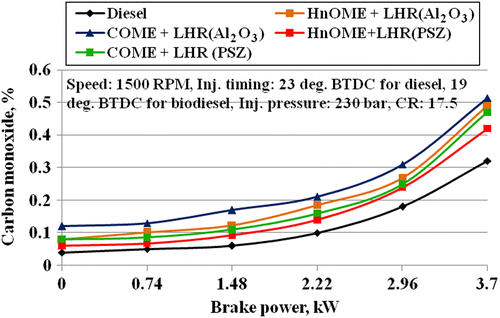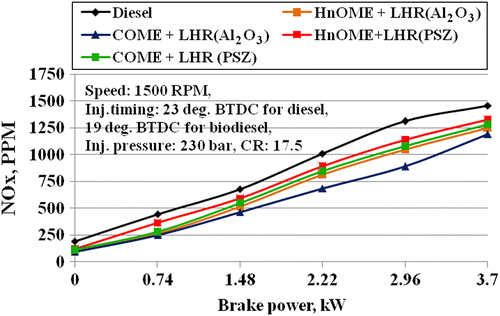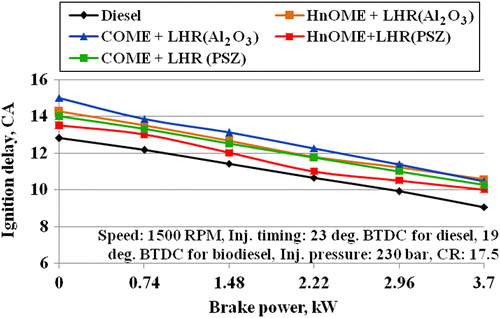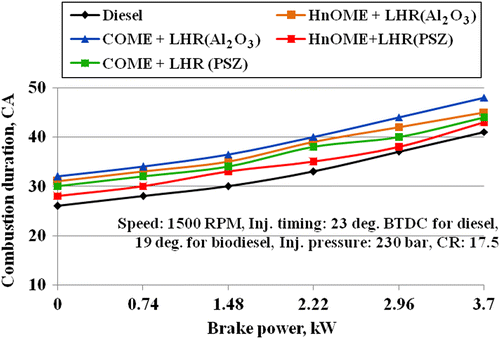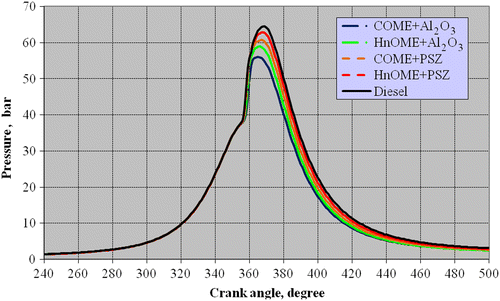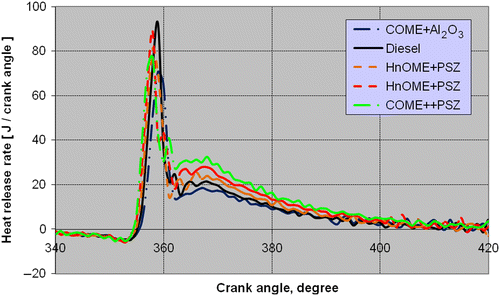Abstract
Owing to the ever-increasing vehicle population, the consumption of diesel fuel in the transportation, agricultural and industrial sectors has increased at an alarming rate. This has led to rapid fossil fuel depletion, ozone depletion and environmental degradation, which have become a serious concern. Search for alternative renewable and clean energy fuel sources to mitigate the emissions of greenhouse gases is continuing, and attempts to find different techniques for efficient utilization of these fuels are also undertaken. Biodiesel being an oxygenated fuel obtained from vegetable oils has received greater attention over the years as a promising alternative to diesel fuel. However, vegetable oils exhibit high viscosity, poor volatility and poor cold-flow characteristics. These characteristics can cause the following problems in the engine when run for a longer duration: injector coking, severe engine deposits, filter gumming, piston ring sticking and thickening of lubrication. These problems can be eliminated or minimized by adopting suitable fuel processing techniques to obtain biodiesels from vegetable oils. The fuel processing techniques vary widely, which include transesterification, supercritical methanolysis, ultrasonic and continuous microwave-assisted transesterification methods. In the present study, the transesterification method is effectively used to obtain biodiesels from non-edible oils of honne and cotton seed. The biodiesels obtained from these oils were used in the unmodified diesel engine to check their feasibility as diesel engine alternatives. Different thermal barrier coatings (TBCs) were applied on the piston, cylinder head, and inlet and exhaust valve surfaces of the diesel engine in order to make it a fully adiabatic engine. The engine with such TBCs is called a low heat rejection engine. For the present study, the TBC of partially stabilized zirconia (PSZ) and aluminium oxide (Al2O3) were selected. Finally, the performance of the diesel engine fuelled with different biodiesels in both conventional and thermal barrier-coated modes was compared. The thermal barrier-coated engine with the PSZ version showed better performance with increased nitric oxide emissions when compared with the Al2O3 coating.
1. Introduction
Energy derived from renewable and alternative fuels is an essential input for the economic growth of any country (Banapurmath Citation2011). In this context, it is quite essential to use alternative fuels as their use are greatly influenced by the factors such as energy security, environmental concerns, foreign exchange savings and socio-economic issues. (Ayhan Citation2007). The importance of alternative fuels was recognized in the early 1900s by Dr Rudolph diesel. The promotion of alternative fuels such as vegetable oils for a compression ignition (CI) engine has gained sustained attention. Currently, it is estimated that India will be able to produce 288 metric tons of biodiesel from a variety of vegetable oils by the end of 2012 (Yaliwal et al. Citation2010). This in turn can supplement about 41.14% of the total demand of diesel fuel consumption of the country (Ashok and Saravanan Citation2005). India has one of the largest programmes for alternative fuels that cover the entire relevant fuel technologies such as biodiesel, biogas, bioethanol and producer gas. Global demand for biodiesel has increased from 6.9 to 44.8 million tons during the periods 2006 and 2010 (Yaliwal et al. Citation2010). In view of this, research has mainly focused on the use of vegetable oils in general and non-edible oils in particular as suitable alternative fuels. Non-edible oils derived from plant seeds are renewable, environment friendly, non-toxic and biodegradable, and they contain no sulphur and aromatic contents and are most promising alternative fuels for a CI engine (Agarwal and Rajamanoharan Citation2009; Ashok and Saravanan Citation2005; Babu and Devardjane Citation2003; Banapurmath et al. Citation2005; Ghadge and Raheman Citation2005). Various non-edible oils such as honne, cotton, Honge, neem, mahua and jatropha oils are abundantly available in India, and their respective biodiesels are an alternative to diesel fuel.
Non-edible oils pose some problems when used directly in an engine as a diesel substitute (Agarwal and Agarwal Citation2007; Banapurmath et al. Citation2008; Canakci Citation2005; Emil et al. Citation2009; Ertan and Canakci Citation2009; Hosmani, Hiremath, and Keri Citation2009; Narayana Reddy and Ramesh Citation2005; Recep, Selim, and Huseyin Citation2000). These problems can be solved if neat vegetable oils are chemically modified to their respective biodiesels that are similar in characteristics to diesel fuel (Alessandro et al. Citation2009; Banapurmath and Tewari Citation2008; Mahanta, Mishra, and Kushwash Citation2006). Differences in the molecular structure of oils greatly influence the physical and chemical processes occurring during the atomization, vaporization, spray pattern and combustion of the fuel when injected into the combustion chamber (Lertsathapornsuk et al. Citation2005). The presence of fatty acids in vegetable oils greatly affects diesel engines when used directly. The different fatty acids present in vegetable oils are palmitic, stearic, lignoceric, oleic and linoleic acids (Amman Citation1988; Ekrem, Tahsin, and Muhammet Citation2006; Jaichandar and Tamilporai Citation2003). These fatty acids in vegetable oils increase smoke emissions and also lead to incomplete combustion due to improper air–fuel mixing. Proper fuel processing or transesterification of vegetable oils can reduce viscosity and increase the cloud and pour points of biodiesels.
The major drawback of the use of biodiesel is its higher viscosity (nearly twice its counterpart diesel fuel) and lower volatility. The use of adiabatic engines is one solution to effectively combust biodiesels in diesel engines. Many studies on the application of the adiabatic or low heat rejection (LHR) concept by using biodiesels in standard diesel engines can be found in the literature (Agarwal and Agarwal Citation2007; Ahmaniemi et al. Citation2004; Amman Citation1988; Banapurmath and Tewari Citation2008; Banapurmath, Tewari, and Hosmath Citation2008; Ekrem, Tahsin, and Muhammet Citation2006; Jaichandar and Tamilporai Citation2003; Sun et al. Citation1993). Various thermal barrier coatings (TBC) of silicon carbide, silicon nitride, aluminium titanate, aluminium magnesium silicate and ceramics such as aluminium oxide (Al2O3) and partially stabilized zirconia (PSZ) have been used. PSZ has been found to be quite desirable for adiabatic engine applications due to its excellent insulating characteristics, strength and thermal expansion characteristics. They are coated on the surfaces of the piston, cylinder head, cylinder liner, and inlet and exhaust valves. The coating thickness varies from 1 to 2 mm. There are some important advantages of coated LHR engines: improved fuel economy, reduced engine noise and multi-fuel capability using low-cetane biodiesel fuels (Agarwal and Agarwal Citation2007; Ahmaniemi et al. Citation2004; Banapurmath and Tewari Citation2008; Banapurmath, Tewari, and Hosmath Citation2008).
A large number of studies on the performance, structure and durability of the LHR engine have also been reported (Hergart Citation2001; Narayana Reddy and Ramesh, Citation2005). However, the results of these investigations are contradictory. Most of these studies have concluded that insulation reduces heat transfer, improves thermal efficiency and reduces exhaust emissions. However, some experimental studies have indicated almost no improvement in thermal efficiency and claimed that exhaust emissions deteriorate when compared with conventional diesel engines.
In the present study, engine combustion chamber elements such as piston, cylinder head and valve faces were coated with two types of TBC such as PSZ and Al2O3. A comparison was made to study the performance and emission characteristics of the engine when coated with two different coatings and with normal uncoated engine fuelled with biodiesels derived from honne and cottonseed oils.
2. Properties of the test fuels
For the present study, non-edible oils derived from honne and cotton seed were selected. These oils were transesterified to obtain their respective biodiesel fuel. Biodiesel from cotton seed oil was extracted according to the following procedure: 1 litre of raw cotton seed oil was heated and maintained at a temperature of 65°C for 30 min to remove moisture content. Then, the oil was titrated against the NaOH solution, which showed about 1% free fatty acids. The moisture-free cotton seed oil (1 l) was heated to a temperature of 55°C in the flask. Then, a mixture of 200 ml methanol and 4 g NaOH was added. The resulting mixture was maintained at the same temperature with a stirrer speed of 400 rpm. After 1 h, the mixture was allowed to settle in a separating funnel for 8 h. Finally, the heavier layer of glycerin was separated out to obtain the biodiesel, which was washed three or four times with a 10 ml acetic acid+hot water solution to remove moisture content and other sediments. The clean cotton oil methyl ester was thus obtained. The yield of the resulting ester was about 94%.
The fuel properties of the biodiesel and non-edible oils and their respective biodiesels were measured in the laboratory. The properties of these oils are shown in Table .
Table 1 Properties of the fuels used.
3. Experimental set-up
The overall view of the experimental set-up is shown in Figure . The engine tests were conducted on a four-stroke, single-cylinder, direct-injection, water-cooled CI engine. The specifications of the engine are given in Table . The engine was operated at a rated speed of 1500 rpm. The engine had a conventional fuel injection system. According to the manufacturer's specification, the injection nozzle used for the diesel had three holes of 0.3 mm diameter with a spray angle of 120° apart and an injector opening pressure of 205 bar along with a static injection timing of 23° before top dead centre (bTDC). The nozzle used for the biodiesel had four holes of 0.3 mm diameter with a spray angle of 90° apart and an injector opening pressure of 230 bar along with a static injection timing of 19° bTDC. The regular governor of the engine was used to control the engine speed. The engine was equipped with a hemispherical combustion chamber having overhead valves that were operated via push rods. The engine was cooled by the circulating water that flowed through the jackets of the engine block and cylinder head. The experiments were conducted at an inlet cooling water temperature of 80°C under a steady-state thermal condition. A piezoelectric pressure transducer was mounted flush with the cylinder head surface to measure the cylinder pressure.
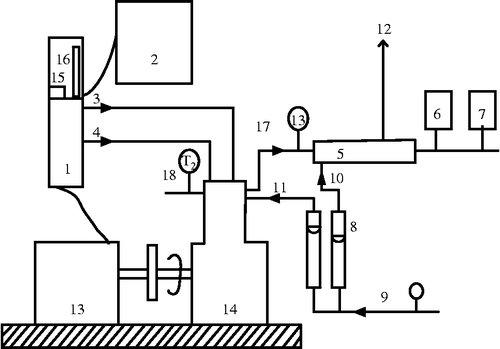
Table 2 Specifications of the engine.
Exhaust gas opacity was measured using the Hartridge smoke opacity meter. Exhaust gas emissions were measured using an exhaust gas analyser (Make: MRU, Model: Delta 1600S). Figures and show the piston and cylinder head coated with PSZ and Al2O3, respectively, to obtain an LHR engine.
4. Results and discussion
The experiments were conducted on the direct-injection CI engine with PSZ and Al2O3 ceramic coatings. Baseline readings were also generated for the existing uncoated diesel engine for a comparative study. The engine was fuelled with honne oil methyl ester (HnOME) and cotton seed oil methyl ester (COME) in both the coated and normal diesel engine operations.
4.1 Performance parameters
4.1.1 Brake thermal efficiency
The effect of brake power on brake thermal efficiency (BTE) for diesel, HnOME and COME in the normal engine operation is shown in Figure . It can be observed that there was a steady increase in BTE as the load increased for the diesel, HnOME and COME operations. The BTE was found to be lowest for the biodiesel operations compared with the diesel operation. This reduction may be due to their lower volatility, higher viscosity and density, leading to poor mixture formation.
4.2 Emission parameters
4.2.1 Smoke opacity
The effect of brake power on smoke opacity for diesel, HnOME and COME in the normal engine operation is shown in Figure . It can be observed that there was an increase in smoke opacity with an increase in load. Smoke opacity was found to be higher for the biodiesel operations than for the diesel operation. This increase may be due to their higher viscosity associated with a heavier molecular structure containing fatty acids, lower volatility and higher density. This results in poor atomization of biodiesels, leading to higher smoke emissions. At an 80% load, smoke opacity values were found to be 61 and 70 HSU for the HnOME and COME operations, respectively, compared with 53 HSU for the diesel operation.
4.2.2 Hydrocarbon (HC) and carbon monoxide (CO) emissions
The effect of brake power on HC and CO emissions for diesel, HnOME and COME is shown in Figures and , respectively. HC emission levels were found to be higher for the biodiesels than for the standard diesel oil. The higher HC and CO emissions in the exhaust of the fuel may be attributed to the polymerization that takes place at the core of the spray and causes the concentration of the spray cone, thereby decreasing the penetration rate. (Bari, Lim, and Yu Citation2002). Low-volatility polymers affect the atomization process and the mixing of the air and fuel, resulting in a locally rich mixture. This feature increases incomplete combustion, and hence higher CO and HC emission levels were observed for both biodiesels. HC emission levels recorded for HnOME and COME in the normal engine operation were found to be 54 and 63 ppm compared with 29 ppm for diesel at an 80% power output.
CO emission levels in the exhaust also showed a similar trend as observed for HC emissions. The CO emission values were 0.14 and 0.18% for the HnOME and COME operations but 0.1% for the diesel operation at an 80% load.
4.2.3 Nitric oxide emissions
The effect of brake power on nitric oxide (NO x ) emissions is shown in Figure for the normal engine operation. It was observed that NO x emission levels were found to be higher for the diesel operation than for the biodiesel operations. The heat release rates for biodiesels were found to be lower during the premixed combustion phase, leading to lower peak temperatures. Nitrogen oxide formation strongly depends on the peak temperature, which explains the observed phenomenon. The nitrogen oxide emission values recorded for HnOME and COME in the normal engine operation were found to be 760 and 735 ppm at an 80% power output compared with 790 ppm for diesel.
4.3 Combustion parameters
4.3.1 Ignition delay
The effect of brake power on ignition delay is shown in Figure . The ignition delay was calculated based on the static injection timing. HnOME and COME showed longer ignition delays compared with diesel. These longer ignition delays could be attributed to the rate of vaporization of the fuel droplets. This in turn depends on the size of the droplets, velocity and distribution, the pressure and temperature inside the cylinder, and the volatility of the fuel itself. The reasons for this observed trend could be the higher viscosity and lower volatility of the biodiesels, leading to poor atomization and poor mixing of the air during the ignition delay period. The lower viscosity of HnOME results in a slightly reduced ignition delay compared to COME engine operation.
4.3.2 Combustion duration
Combustion duration, shown in Figure , was calculated based on the duration between the start of combustion and 90% cumulative heat release. It was observed that combustion duration increased with an increased power output for all the fuels tested, which was due to the increased quantity of the fuels injected. A higher combustion duration was observed with esters than with diesel, which could be attributed to the lower premixed combustion phase. Combustion duration for HnOME and COME were found to be longer than that for diesel due to its longer diffusion combustion phase. Combustion duration was observed to be shorter for HnOME than for COME, yet longer than that for diesel.
4.3.3 Cylinder pressure
Figure shows the variation in pressure versus crank angle for diesel, HnOME and COME at optimum injection timings. It was observed that the peak pressure increased as the load increased, and combustion started later for HnOME and COME than for diesel fuel in the normal diesel engine operation. A reduction in cylinder pressure was observed for the HnOME and COME operation. This reduction could be attributed to the incomplete combustion and lower energy content of the respective biodiesels compared with diesel fuel with reduced BTE. The peak cylinder pressure was observed to be higher for HnOME than for COME. The reason could be attributed to its higher premixed combustion phase, as shown in Figure .
4.3.4 Heat release rate
Figure shows the heat release rate for all the fuels tested. It can be observed that a shorter premixed heat release portion occurs for the biodiesels, despite their increased ignition delay. The heat release rates for both HnOME and COME operations were found to be lower than that for the diesel operation. A reduced heat release rate during the premixed combustion phase and an increased heat release rate during the diffusion combustion phase were observed for both HnOME and COME operations compared with the diesel operation. This leads to an increased exhaust gas temperature.
4.4 Comparison of LHR coatings for COME and HnOME
This section provides a comprehensive comparison of the performance of the biodiesels with different coatings used in the diesel engine.
4.4.1 Brake thermal efficiency
Figures shows the effect of brake power on BTE for the biodiesel fuelled engine when coated with the TBC of PSZ and Al2O3. The performance of the biodiesels improved because of the reduced heat transfer rate for the coated engine operation compared with the normal engine operation. The positive effect of the increased in-cylinder temperature due to such thermal coatings is the reason for this observed trend (Hanbey and Ozturk Citation2010). For the biodiesels tested, a higher BTE was found with PSZ-coated engine compared to Al2O3-coated one. The reduced heat transfer rate from the PSZ-coated engine compared with the Al2O3-coated engine could be the reason for this observed trend. The heat-resisting property of PSZ is comparatively better than that of Al2O3. Compared with Al2O3, the PSZ-coated engine exhibited an increased BTE by 4.5% and 5% when fuelled with COME and HnOME respectively. The BTE values were found to be 24.85%, 24.0%, 26.7% and 25.6% for the HnOME+LHR (Al2O3), COME+LHR (Al2O3), HnOME+LHR (PSZ) and COME+LHR (PSZ) operations, respectively, compared with 26.2% for the diesel operation at an 80% load.
4.4.2 Smoke opacity
The effect of brake power on smoke opacity for both the biodiesels provided with the TBC of PSZ and Al2O3 is shown in Figure . The coating of the ceramic elements on the combustion chamber increases in-cylinder soot oxidation due to a higher surface temperature, resulting in improved combustion efficiency (Hanbey and Ozturk Citation2010). A significant decrease in smoke density for the PSZ-coated engine was observed compared with the Al2O3-coated engine. Better combustion with a reduced heat transfer rate from the PSZ-coated engine compared with the Al2O3-coated one could be the reason for this observed trend. PSZ being a ceramic material has a very low thermal conductivity, good strength and low thermal expansion coefficient, and it can withstand a much higher temperature than Al2O3. The smoke emission levels were found to be 63, 67, 58 and 61 HSU for the HnOME+LHR (Al2O3), COME+LHR (Al2O3), HnOME+LHR (PSZ) and COME+LHR (PSZ) operations, respectively, compared with 53 HSU for the diesel operation at an 80% load.
4.4.3 HC and CO emissions
Figures and show the effect of the variations in brake power on HC and CO emissions for the biodiesels with the TBC of PSZ and Al2O3. For the biodiesel operations, the HC and CO emission levels were found to be lower in the thermal barrier-coated engine than in the uncoated or normal engine. This decrease in HC and CO emission levels in the coated engine may be attributed to the increased post-combustion temperature due to the decreased heat loss to both cooling media, cylinder and engine parts. This may lead to the addition of more unburned HC to the combustion. The reduction in both HC and CO emission levels is due to the decreased quenching distance and the increased lean flammability limit. The higher temperatures prevailing in both gases and at the combustion chamber walls of the thermal barrier-coated engine assist in permitting the oxidation reactions to proceed closer to completion (Ahmaniemi et al. Citation2004). Of the two coated engines, the lowest HC and CO emission levels were found in the PSZ-coated engine. The higher surface temperature prevailing inside the PSZ-coated combustion chamber improves combustion with higher heat utilization using the biodiesel operation. The HC emission levels were found to be 46, 52, 39 and 41 ppm for the HnOME+LHR (Al2O3), COME+LHR (Al2O3), HnOME+LHR (PSZ) and COME+LHR (PSZ) operations, respectively, compared with 36 ppm for the diesel operation at an 80% load. Similarly, the CO emission levels were found to be 0.265%, 0.29%, 0.24% and 0.26% for the HnOME+LHR (Al2O3), COME+LHR (Al2O3), HnOME+LHR (PSZ) and COME+LHR (PSZ) operations, respectively, compared with 0.18% for the diesel operation at an 80% load.
4.4.4 Nitric oxide emissions
The effect of brake power on NO x emissions for both the biodiesels provided with the TBC of PSZ and Al2O3 is shown in Figure . Lower NO x emission levels were observed in the normal engine compared with the thermal barrier-coated engine. The increased post-combustion temperature causes an increase in NO x emission levels compared with the uncoated engine. Factors facilitating and accelerating the reaction between oxygen and nitrogen increases the formation of NO x . The NO x emission levels were found to be 1140, 1080, 1050 and 890 ppm for the HnOME+LHR (PSZ), COME+LHR (PSZ), HnOME+LHR (Al2O3) and COME+LHR (Al2O3) operations, respectively, compared with 1310 ppm for the diesel operation at an 80% load.
4.4.5 Ignition delay
The effect of brake power on ignition delay is shown in Figure . The ignition delay was calculated based on the static injection timing. HnOME and COME showed longer ignition delays compared with diesel. The reasons for this observed trend are the higher viscosity and lower volatility of the biodiesels, leading to poor atomization and poor mixing of the air during the ignition delay period (Suresh, Kamath, and Banapurmath Citation2013). However, the increased gas temperature in the thermal barrier-coated engine improved combustion with a shortened ignition delay and positively affected both chemical and physical reactions. From Figure , it can be observed that PSZ caused a lower ignition delay than did Al2O3.
4.4.6 Combustion duration
Combustion duration shown in Figure was calculated based on the duration between the start of combustion and 90% cumulative heat release. It was observed that combustion duration increased with an increase in the power output for all the fuels tested. This increase is due to the increase in the quantity of the fuels injected. Combustion duration for HnOME and COME was found to be longer than that for diesel due to its longer diffusion combustion phase (Suresh, Kamath, and Banapurmath Citation2013). However, it could be lowered with increased cylinder temperature by incorporating the LHR facility. Combustion duration for HnOME and COME was observed to be shortened with the PSZ coating, yet longer than that for diesel.
4.4.7 Cylinder pressure
Figure shows the variation in pressure versus crank angle for the HnOME and COME oils. Combustion started later for both the biodiesels compared to diesel in both versions LHR and standard engine modes of operation. The PSZ coating exhibited a slightly higher peak pressure compared to Al2O3.
4.4.8 Heat release rate
Figure compares the heat release rates at an 80% load. The premixed burning phase associated with a high heat release rate was found to be significant for the standard diesel operation, and responsible for the higher peak pressure and higher rates of pressure rise (Suresh, Kamath, and Banapurmath Citation2013). This trend could be attributed to the higher thermal efficiency observed for diesel fuel operation. The heat release rate depends on the premixed fuel and air mixture, energy content and flame velocity of the fuels used. The diffusion combustion and burn rate is controlled by the mixing of the fuel and air. It can be observed that combustion started earlier for the coated engine at all engine loads for all the tested fuels. At higher engine loads, the heat release rate for the thermal barrier-coated engine was found to be higher. The crank angle at which the maximum heat release rate occurred was in advance for the thermal barrier-coated engine compared with the normal engine. The heat release rate was lower for the PSZ-coated engine than for the Al2O3-coated engine. This decrease could be attributed to the higher ignition delay for the Al2O3 coating compared with the PSZ coating. This may be due to the fact that more fuel is accumulated in the combustion chamber to release higher heat during the premixed combustion phase (Mohamed Musthafa, Sivapirakasam, and Udayakum Citation2011).
5. Conclusions
The following conclusions are made from the present study:
The study on the performance of diesel, HnOME and COME in the CI engine indicates that no major modifications are required in the existing diesel engine. The use of non-edible oils avoids the conflict between food and energy security.
BTE for the HnOME and COME operations was slightly lower than that for the diesel fuel operation. At the operating conditions, the BTE of the engine decreased by 4.9% and 9.5% for the HnOME and COME operations compared with the diesel fuel operation.
The smoke opacity, HC and CO emission levels were slightly higher for the HnOME and COME operations than for the diesel fuel operation. Smoke opacity was increased by 15.8% and 32.5%, HC emission levels increased by 41.1% and 51% and CO emission levels increased by 35.6% and 44.2% for the HnOME and COME operations compared with the diesel fuel operation.
The NO x emission levels for the biodiesels were found to be lower than that for diesel fuel. The levels were decreased by 4.2% and 7.8% for the HnOME and COME operations compared with the diesel fuel operation.
The LHR operation with HnOME and COME produced an improvement in BTE when compared with the standard engine operation. However, this improvement did not match with the standard diesel engine operation. The BTE values were increased by 4% and 3.2%, respectively, compared with the normal engine operation for the respective biodiesels.
Higher smoke, HC and CO emission levels were observed for the HnOME and COME operations than for the standard diesel operation. The emission levels were reduced in the thermal barrier-coated engine or the LHR engine.
The LHR operation with HnOME and COME appeared to produce slightly higher NO x levels than that for the normal engine operation with the biodiesels, whereas the standard diesel operation exhibited maximum NO x emission levels.
The heat release rate was better for the HnOME and COME operation with the LHR facility compared with the normal engine operation, resulting in improved BTE.
Based on the engine test, it could be concluded that esters of vegetable oils (HnOME and COME) can replace diesel fuel for running the existing diesel engine without any major engine modification, and its performance with PSZ coating is better than that with Al2O3 coating.
Notes
1. Email: [email protected]
2. Email: [email protected]
References
- Agarwal, D. , and A. K. Agarwal . 2007. “Performance and Emission Characteristics of A Jatropha Oil (Preheated and Blends) in a Direct Injection Compression Ignition Engine.” Journal of Applied Thermal Engineering 27: 2314–2323.
- Ahmaniemi, S. , M. Tuominen , M. Vippola , P. Vuoristo , T. Mantyla , F. Cernuschi , Gualco , A. Bonadei , and R. Di. Maggio . 2004. “Characterization of Modified Thick Thermal Barrier Coatings.” Journal of Thermal Spray Technology 13 (3): 361–369.
- Alessandro, Schondorn , Ladommato S. Nicos , Willians Jogn , Allan Robert , and Reogerson John . 2009. “The Influence of Molecular Structure of Fatty Acid Monoalkyl Esters on Diesel Combustion.” Combustion and Flame 157: 1396–1412.
- Amman, C. A. 1988. “Promises and Challenges of the Low-Heat-Rejection Diesel.” Journal of Engineering for Gas Turbines and Power 110: 475–481.
- Ashok, M. P. , and C. G. Saravanan . 2005. “The Performance and Emission Characteristics of Emulsified Fuel in DI Diesel Engine.” Proceeding of Institute of Mechanical Engineers IMechE Part D, Journal of Automobile Engineering 221: 893–900.
- Agarwal, Avinashkumar , and K. Rajamanoharan . 2009. “Experimental Investigations of Performance and Emissions of Karanja Oil and its Blends in a Single Cylinder Agricultural Diesel Engine.” Applied Energy 86: 106–112.
- Ayhan, Demirbas . 2007. “Progress and Recent Trends in Biofuels.” Progress in Energy and Combustion Science 33 (1): 1–18.
- Babu, A. K., and J. Devardjane . 2003. “Vegetable Oils and Their Derivatives as Fuels for C.I. Engines – An Overview.” Society of Automotive Engineers, Paper No.: 0100767 pp. 406–417.
- Banapurmath, N. R., P. G. Tewari, Y. H. Basavarajappa, and V. S. Yaliwal . 2005. “Performance of Honge (Pongamia pinnata) Oil Blends in a Diesel Engine.” In Paper Presented at the XIX NCICEC, Annamalai University, Chidambaram, India, pp. 1–6.
- Banapurmath, N. R. , P. G. Tewari , and R. S. Hosmath . 2008. “Combustion and Emission Characteristics of a Direct Injection, Compression–Ignition Operated on Honge Oil, HOME and Blends of HOME and Diesel.” International Journal of Sustainable Engineering 1 (2): 80–93.
- Banapurmath, N. R. , and P. G. Tewari . 2008. “Performance of a Low Heat Rejection Engine Fuelled with Low Volatile Honge Oil and Its Methyl Ester (HOME).” Proceeding of Institute of Mechanical Engineers IMechE, Part A Journal of Power and Energy 222: 323–330.
- Banapurmath, N. R. 2011. Renewable and Alternative Fuelled Diesel Engines, pp. 1–125. LAP LAMBERT Academic Publishing, GmbH., ISBN 978-3-8443-0789-4.
- Bari, S. , T. H. Lim , and C. W. Yu . 2002. “Effect of Preheating of Crude Palm Oil (CPO) on Injection System.” Performance and Emission of a Diesel Engine Renewable Energy 27: 339–351.
- Canakci, M. 2005. “Performance and Emission Characteristics of Biodiesel from Soyabeen Oil.” Proceeding of Institute of Mechanical Engineers IMechE, Part D, Journal of Automobile Engineering 219 (7): 915–922.
- Ekrem, B. , E. Tahsin , and C. Muhammet . 2006. “Effects of Thermal Barrier Coating on Gas Emissions and Performance of a LHR Engine with Different Injection Timings and Valve Adjustments.” Energy Conversion and Management 47: 1298–1310.
- Emil, Akbar , Yaakob Zahira , Kamarudin Siti Kartom , Ismail Manal , and Salimon Jumat . 2009. “Characteristic and Composition of Jatropha Curcas Oil Seed from Malaysia and its Potential as Biodiesel Feedstock.” European Journal of Scientific Research, ISSN 1450-216X 29 (3): 396–403.
- Ertan, Alptekin , and Mustafa Canakci . 2009. “Characterization of the Key Fuel Properties of Methyl Ester–Diesel Fuel Blends.” Fuel 88 (1): 75–80.
- Ghadge, S. V. , and Hifjur Raheman . 2005. “Biodiesel Production from Mahua (Madhuca Indica) Oil Having High Free Fatty Acids.” Biomass and Bioenergy 28: 601–605.
- Jaichandar, S., and P. Tamilporai . 2003. “Low Heat Rejection Engines – An Overview.” Society of Automotive Engineers, Paper No.: 2003-01-0405, USA.
- Hanbey, Hazar , and Ugur Ozturk . 2010. “The Effects of Al2O3/TiO2 Coating in a Diesel Engine on Performance and Emission of Corn Oil Methyl Ester.” Renewable Energy 35: 2211–2216.
- Hergart, C. 2001. “Modeling Combustion and Soot Emissions in a Small Bore Direct Injection Diesel Engine.” PhD thesis, RWTH Aachen.
- Hosmani, K. M. , V. B. Hiremath , and R. S. Keri . 2009. “Renewable Energy Sources from Michelia Champaca and Garcinia Indica Seed Oil – A Rich Source of Oil.” Biomass and Bioenergy 267–270.
- Lertsathapornsuk, V. , P. Ruangying , R. Pairintra , and K. Krisnangkura . 2005. Continuous Transmethylation of Vegetable Oils by Microwave Irradiation. Bangkok, Thailand: School of Energy and Materials, King Mongkut's University of Technology Thonburi. The 1st Conference on Energy Network of Thailand, Jomtien.
- Mahanta, P. , S. C. Mishra , and Y. S. Kushwash . 2006. “An Experimental Study of Pongamia Pinnata L. Oil as a Diesel Substitute.” Proceeding of Institute of Mechanical Engineers IMechE, Part A, Journal of Power and Energy 220 (7): 803–808.
- Mohamed, Musthafa M. , S. P. Sivapirakasam , and M. Udayakum . 2011. “Comparative Studies on Fly Ash Coated Low Heat Rejection Diesel Engine on Performance and Emission Characteristics Fueled by Rice Bran and Pongamia Methyl Ester and Their Blend with Diesel.” Energy 36: 2343–2351.
- Narayana Reddy, J. , and A. Ramesh . 2005. “Parametric Studies for Improving the Performance of a Jatropha Oil-Fuelled Compression Ignition Engine.” Renewable Energy 31: 1994–2016.
- Recep, A. , C. Selim , and S. Y. Huseyin . 2000. “The Potential of Using Vegetable Oil Fuels as Fuel for Diesel Engines.” Energy Conversion and Management 42: 529–538.
- Sun, X., W. G. Wang, D. W. Lyons, and X. Gao . 1993. “Experimental Analysis and Performance Improvement of Single Cylinder Direct Injection Turbocharged Low Heat Rejection Engine.” Society of Automotive Engineers, Paper No.: 930989, USA.
- Suresh, G. , H. C. Kamath , and N. R. Banapurmath . forthcoming. “Effect of Injection Timing, Injector Opening Pressure and Nozzle Geometry on the Performance of Cotton Seed Oil Methyl Ester Fuelled Diesel Engine.” International Journal of Sustainable Engineering.
- Yaliwal, V. S. , S. R. Daboji , N. R. Banapurmath , and P. G. Tewari . 2010. “Production and Utilization of Renewable Liquid Fuel in a Single Cylinder Four Stroke Direct Injection Compression Ignition Engine.” International Journal of Engineering Science and Technology 2 (10): 5938–5948.

